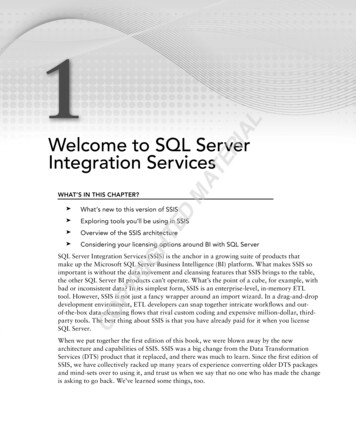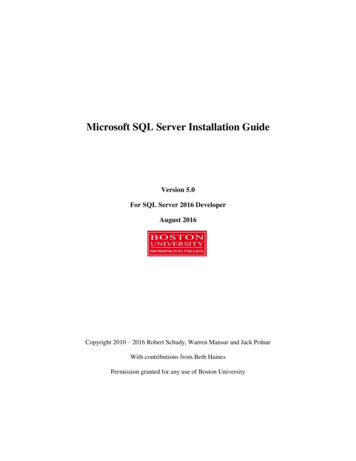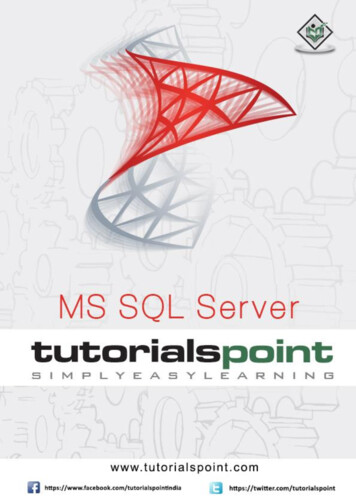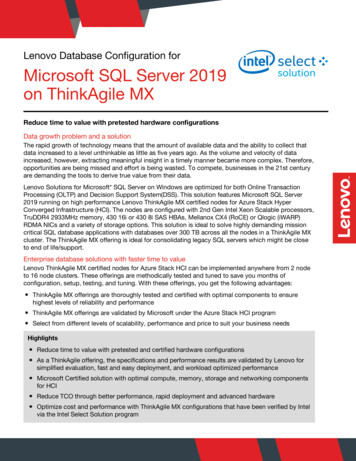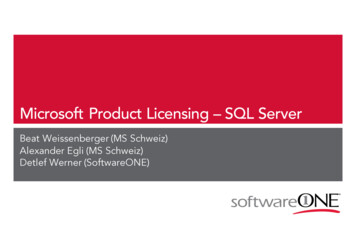![SQL Server TSQL [Read-Only]](/img/17/sql-server-tsql.jpg)
Transcription
SQL ServerServer SideProgrammingusing T-SQLGreat Bison – Altamira Cave 17000 BC1
Microsoft SQL Server.Worldwide Database MarketJune 18, 2007 –Worldwide relational database managementsystems (RDBMS) total software revenue totaled 15.2 billion in 2006, a 14.2 percent increase from2005 revenue of 13.3 billion.Exxon posts biggest annual profit on record for a U.S. corporationRecord oil prices help the world's largest public oil companyearn 39.5 billion in m/it/page.jsp?id 507466Additionalinformation is available in the Gartner report“Market Share: Relational Database Management Systems by Operating System, Worldwide, 2006.”The report is available on Gartner’s Web site at http://www.gartner.com/DisplayDocument?ref g search&id 507295&subref simplesearch.2
Microsoft SQL Server.Worldwide Database Market20062006MarketShare (%)20052005MarketShare (%)2005-2006Growth 4.2CompanyOtherVendorsTotalAdditional information is available in the Gartner report“Market Share: Relational Database Management Systems by Operating System, Worldwide, 2006.”The report is available on Gartner’s Web site at http://www.gartner.com/DisplayDocument?ref g search&id 507295&subref simplesearch.3
Microsoft SQL Server.2006 Worldwide Database MarketAdditional information is available in theGartner report“Market Share: Relational DatabaseManagement Systems by Operating System,Worldwide, 2006.”The report is available on Gartner’s Web site athttp://www.gartner.com/DisplayDocument?ref g search&id 507295&subref simplesearch.4
Microsoft SQL Server.2005 Global Database MarketTop Five (% Teradata2.9Others10.8 14.6 Billion DollarsMay 24, 2006 – The worldwide market forrelational database management systems(RDBMS) grew by 9.4% to 14.6 billion in2005, according to preliminary figuresreleased by IDC.These numbers reflect steady growth for theRDBMS software market, indicating acontinued increase in the deployment ofrelational databases.Takeb from: http://www.idc.com/ Visited on 22-Oct-20065
Microsoft SQL Server.SQL Server 2005Microsoft-SQL Server 2005 is a relational database managementsystem (RDBMS) from Microsoft that's designed for the enterpriseenvironment.SQL Server runs on T-SQL (Transact -SQL), a set of programmingextensions from Sybase and Microsoft that enhances the capabilitiesof standard SQL.According to Microsoft the SQL Server 2005 provides improvedflexibility, scalability, reliability, and security to database applications,and makes them easier to create and deploy, it also includes moreadministrative support.6
Microsoft SQL Server.SQL Server 2005 and SYBASEExcerpts taken from (reliable ? accurate ? but always entertaining) www.wikipedia.comon Nov-2006Sybase Inc. (NYSE: SY) is a software company specializing in relational databasemanagement systems and database-related products. "Sybase" is also commonly used torefer to Adaptive Server Enterprise, the company's flagship relational database system.Sybase's original architects were Dr. Robert Epstein and Tom Haggin who both had workedat Briton-Lee and the University of California, Berkeley Department of Computer Sciences(1984).The pioneering "University Ingres" relational database system, developed at UC Berkeley,led to Briton-Lee, Sybase, Ingres (Computer Associates) Informix (IBM) and NonStop SQL(Tandem), as well as the majority of other SQL systems currently in use.Sybase became the number 2 database system behind Oracle, after making a deal withMicrosoft to share the source code for Microsoft to remarket on the OS/2 platform as "SQLServer". At the time, Sybase called the database server "Sybase SQL Server".7
Microsoft SQL Server.SQL Server 2005 and SYBASECONT. Excerpts taken from www.wikipedia.com on Nov-2006Until version 4.9, Sybase and Microsoft SQL server were virtually identical. Due to disagreements betweenthe two companies over revenue sharing (or lack thereof), Sybase and Microsoft decided to split the codelines and went their own way, although the shared heritage is very evident in the Transact-SQL (TSQL)procedural language as well as the basic process architecture. The big difference is that Sybase has aUnix heritage, while Microsoft sprung from that original Unix architecture and was adapted and optimizedonly for the Microsoft Windows NT operating system. Sybase continues to offer versions for Windows,several flavors of Unix, and for Linux.Sybase suffered a major downturn in fortune in the latter half of the 1990s when Informix started outsellingit by a wide margin. Today Informix is no longer an independent company (having been bought by IBM).Today Sybase is well behind its major competitors in the enterprise database market, with 3% marketshare (InformationWeek March 05).Sybase has recently returned to profitability under the management of John Chen, and continues toreinvent itself with a new 'Unwired Enterprise' strategy. The 'Unwired Enterprise' vision is about allowingcompanies to deliver data to mobile devices in the field as well as traditional desktops, and combinestechnology from Sybase's existing data management products with its new mobility products. Sybase hasexpanded into the mobile and wireless space through buyouts of smaller networking and wirelesscompanies. Through its mobility subsidiary, launched in 2000, iAnywhere Solutions, Sybase has becomethe leader of the mobile database market with SQL Anywhere.8
Microsoft SQL Server.SQL Server 2005 Technologies9
Microsoft SQL Server.SQL Server 2005 TechnologiesSQL Server Database Engine. The Database Engine is the core service forstoring, processing, and securing data in either a relational (tabular) format oras XML documents.SQL Server Analysis Services. Analysis Services delivers online analyticalprocessing (OLAP) and data mining functionality for business intelligenceapplications.SQL Server Integration Services (SSIS). Integration Services is anenterprise data transformation and data integration solution that you can useto extract, transform, and consolidate data from disparate sources and move itto single or multiple destinations.SQL Server Replication. Replication is a set of technologies for copying anddistributing data and database objects from one database to another and thensynchronizing between databases to maintain consistency.10
Microsoft SQL Server.SQL Server 2005 TechnologiesSQL Server Reporting Services. Reporting Services is a server-basedreporting platform that you can use to create and manage tabular, matrix,graphical, and free-form reports that contain data from relational andmultidimensional data sources. The reports that you create can be viewed andmanaged over a Web-based connection.SQL Server Notification Services. Notification Services is the platform fordeveloping and deploying applications that generate and send notifications tothousands or millions of subscribers, and deliver them to a wide variety ofdevices.SQL Server Service Broker. Service Broker also provides integration,queueing, and a message-based communication platform that can be used tolink disparate application components into a functioning whole.Full-Text Search. SQL Server contains the functionality to issue full-textqueries against plain character-based data in SQL Server tables.11
Microsoft SQL Server.SQL Server Management StudioSQL Server Management Studio is a suite of administrative tools for managingthe components belonging to SQL Server. Including Code Editor is a script editor for writing and editing scripts. There arefour versions: the SQL Query Editor, MDX Query Editor, XML QueryEditor, and SQL Mobile Query Editor. Object Explorer for locating, modifying, scripting or running objectsbelonging to instances of SQL Server. Template Explorer for locating and scripting templates. Solution Explorer for organizing and storing related scripts as parts of aproject. Properties Window for displaying the current properties of selectedobjects.12
Microsoft SQL Server.SQL Server Management Studio13
Microsoft SQL Server.SQL Server Management Studio14
Microsoft SQL Server.SQL Server Management Studio15
Microsoft SQL Server.SQL Server Management StudioExploring Database1.Connect to the COMPANYdatabase2.Explore the contents ofselected database16
Microsoft SQL Server.SQL Server Management StudioTable Structure1.Select a table.2.Right-click.3.Select MODIFY option tosee/change structure of atable.17
Microsoft SQL Server.SQL Server Management StudioMultiple Databases1.Select another databaseand explore a table.2.Right-click onNorthwindSQL.3.Open the Product table18
Microsoft SQL Server.SQL Server Management StudioCreating 0bjects(using a script)1.Select the COMPANYdatabase and create anew table2.Click on “New Query”3.Type code (screen)4.Hit F5 to executebatch5.You may also use theGUI interface to “AddNew Table”19
Microsoft SQL Server.SQL Server Management StudioMixing Databases /Temporary Tables1.Double dot to reach other SQLdatabase table. For exampleNorthWindSQL.Products2.Prefix with # a table name tocreate a temporary table. Forexample #MyData20
Microsoft SQL Server.SQL Server Management StudioExamples:select * into #EmpCopy from employeeTemporary TablesPrefix with # a table name tocreate a temporary table. Forexample #EmpCopyNotation N’myTable’ indicatesUnicode string (not needed forGermanic – Romance languages)create table #Auditing (Clock DateTime, Msg nvarchar1(100) )Related TopicsDrop Table myTableIf exists (select * from sysObjects where name N’myTable’)drop table myTable21
Microsoft SQL Server.SQL Server Management StudioDatabase Diagramexposing Referential-Integrity22
Microsoft SQL Server.Useful Functions-- useful system functionsselectuser, current timestamp, @@servername, @@versiondbo2006-10-22 14:57:02.233CARIBEMicrosoft SQL Server 2005 - 9.00.1399.06 (Intel X86) Oct 14 200500:33:37 Copyright (c) 1988-2005 Microsoft Corporation StandardEdition on Windows NT 5.1 (Build 2600: Service Pack 2)use Companyselect db name()Company23
Microsoft SQL Server.What is T-SQL ?T-SQLTransac-SQL24
Microsoft SQL Server.What is T-SQL ?T-SQL (Transact-SQL) is a set of programming extensions fromSybase and Microsoft that adds procedural features to theStructured Query Language (SQL) including sequential logic, structured programming, transaction control, conditional logic, iteration, recursion, exception and error handling, row processing, and declared variables.Microsoft's SQL Server and Sybase's SQL server support T-SQLstatements.25
Microsoft SQL Server.T-SQL Language ElementsTransact-SQL element Description Identifiers. Names of objects such as tables, views, columns, databases,and servers. Data Types. Define the types of data that are contained by data objects,such as columns, variables, and parameters. Functions. Routines that take zero or one or more input values and return ascalar value or a tabular set of values. Expressions. Units of syntax that SQL Server can resolve to single values. Operators in Expressions. Work with one or more simple expressions toform a more complex expression. Comments. Pieces of text included to explain the purpose of the statement. Reserved Keywords. Words that are reserved for use by SQL Server andshould not be used for the names of objects in a database.26
Microsoft SQL Server.T-SQL IDENTIFIERSRegular identifiersSalary @Salary Salary123 Boss SalaryDelimited identifiersAre enclosed in double quotation marks (") or brackets ([ ]).[Big Salary]“StrangeName” [First Name]Rules for Regular Identifiers1. The first character must be one of the following: A letter The underscore ( ), "at" sign (@), or number sign (#). #Name denotes a temporary table or procedure. ##Name denotes a global temporary object. @@Name usually denotes TSQL global functions2. Other valid symbols are: Letters, digits, @, , (up to 128 char.)27
Microsoft SQL Server.T-SQL IDENTIFIERSRegular identifiersSalary @Salary Salary123 Boss SalaryDelimited identifiersAre enclosed in double quotation marks (") or brackets ([ ]).[Big Salary]“StrangeName” [First Name]Examplesdeclare @var1 intdeclare @var2 numeric(10,2), @var3 nvarchar(20)28
Microsoft SQL Server.Data ngsUnicodeCharacterStringsBinaryStringsOtherData harbinaryimagevarbinarycursortimestampsql me29
Microsoft SQL Server.SQL-Server FunctionsFunction categoryDescriptionAggregate Functions (Transact-SQL)Summary operations. Examples are COUNT, SUM, MIN, and MAX.Configuration functionsScalar functions that return information about configuration settings.Cryptographic Functions (Transact-SQL)Support encryption, decryption, digital signing, and the validation of digital signatures.Cursor functionsReturn information about the status of a cursor.Date and Time functionsChange date and time values.Mathematical functionsPerform trigonometric, geometric, and other numeric operations.Metadata functionsReturn information about the attributes of databases and database objects.Ranking functionsNondeterministic functions that return a ranking value for each row in a partition.Rowset Functions (Transact-SQL)Return the rowsets that can be used in the place of a table reference in a Transact-SQLstatement.Security functionsReturn information about users and roles.String functionsChange char, varchar, nchar, nvarchar, binary, and varbinary values.System functionsOperate on or report on various system level options and objects.System Statistical Functions (Transact-SQL)Return information about the performance of SQL Server.Text and image functionsChange text and image values.30
Microsoft SQL Server.SQL-Server INCHECKSUMSUMCHECKSUM AGGSTDEVCOUNTSTDEVPCOUNT @@LOCK TIMEOUT@@SPID@@MAX CONNECTIONS@@TEXTSIZE@@MAX PRECISION@@VERSION@@NESTLEVEL@@CURSOR ROWS@@FETCH STATUSCURSOR TRTRIMSOUNDEXSPACESTRSTUFFSUBSTRINGUNICODEUPPER31
Microsoft SQL Server.SQL-Server FunctionsDate ROUNDSIGNSINSQRTSQUARETANMetaData@@PROCIDCOL LENGTHCOL EXDB IDDB NAMEFILE IDFILE IDEX (Transact-SQL)FILE NAMEFILEGROUP IDFILEGROUP OPERTYFULLTEXTSERVICEPROPERTYINDEX COLINDEXKEY PROPERTYINDEXPROPERTYOBJECT IDOBJECT NAMEOBJECTPROPERTYOBJECTPROPERTYEXSQL VARIANT PROPERTYTYPE IDTYPE NAMETYPEPROPERTY32
Microsoft SQL Server.Procedural T-SQLUsing batchesA batch is a group of one or more Transact-SQL statements that are sent froman application to the server as one unit.Using stored proceduresA stored procedure is a group of Transact-SQL statements that have beenpredefined and precompiled on the server. They can accept parameters, andreturn result sets, return codes, and output parameters to the caller.Using triggersA trigger is a special type of stored procedure. It is not called directly byapplications. It is instead executed whenever a user performs a specifiedmodification (INSERT, UPDATE, or DELETE) to a table.Using scriptsA script is a series of Transact-SQL statements stored in a file. The file can beused as input to the sqlcmd utility or SQL Server Management Studio Code33editor.
Microsoft SQL Server.Flow-Control, Iteration ORGOTOWHILE34
Microsoft SQL Server.Var Declaration – Assignment Statement-- assignment operator (SELECT or SET)declare @var1 intdeclare @var2 numeric(10,2), @var3 nvarchar(20)set @var1 123select @var1 123 -- same as previous assignmentset @var2 19.99set @var3 'Juan Valdez'set @var2 CAST(@var1 as numeric(10,2) )set @var2 CONVERT(numeric, @var1)set @var3 'Room No. ' Str(@var1)35
Microsoft SQL Server.Flow-Control StatementsBEGINstatement-1statement-2 statement-nENDIF @Grade 75print ‘Pass’ELSEprint ‘Fail’36
Microsoft SQL Server.Flow-Control Statementsdeclare @n intset @n 5declare @n intWHILE @n 0BEGINprint 'n ' str(@n)set @n @n - 1ENDset @n @@rowCountselect * from employeeIF @n 0print 'No data found'ELSEprint 'Total rows: ' str(@n)37
Microsoft SQL Server.WAITFOR Flow-Control StatementsThe following example uses the DELAY keyword to wait for two seconds beforeperforming a SELECT statement:WAITFOR DELAY '00:00:02'SELECT * FROM Employee;The following example uses the TIME keyword to wait until 10 P.M. to perform acheck of the Company database to make sure that all Projects are in progressUSE Company;GOBEGINWAITFOR TIME '22:00:00';exec CloseTheGatesEND;GO38
Microsoft SQL Server.Binding Local Variables with SQL statementsBEGINdeclare @idintdeclare @sal moneydeclare @name nvarchar(20)select @id ssn, @sal salary, @name fnamefrom employeewhere lname like 'Smith%'print str(@id) ' ' str(@sal) ' ' @nameENDGo39
Microsoft SQL Server.Binding Local Variables with SQL statementsdeclare @OldSalary moneyupdate employeeset @OldSalary salary,salary salary 1where ssn 123456789print 'Old salary: ' str(@OldSalary)40
Microsoft SQL Server.Using the global @@ERROR variableBEGINupdate employeeset salary salary / 0where ssn 123456789if @@error 0print 'Some bizarre problem ' 'happened here! - ' 'call Xagents Mulder & Scully'ENDMsg 8134, Level 16, State 1, Line 2Divide by zero error encountered.The statement has been terminated.Some bizarre problem happend here! - call Mulder and Scully41
Microsoft SQL Server.Using the global @@ROWCOUNT variableDelete employees working for dno 4 (then restore the table)-- create temporary copy of the EMPLOYEE tableselect * into #EmpCopy from employeegodeclare @myCount intBEGINbegin transactiondelete from #EmpCopy where dno 4-- @@rowCount tells how many rows were affected in previous stm.set @myCount @@rowCountif @myCount 0 beginselect * from #EmpCopyprint 'Deleted rec. ' str(@myCount)rollbackprint 'employee table restored'endelse beginprint 'NO rec. deleted ' str(@myCount)commitendENDselect * from #EmpCopy42
Microsoft SQL Server.Using the global @@ROWCOUNT variableTransaction ProcessingBegin Transactionstatementstatement statementCommit (or Rollback)43
Microsoft SQL Server.Using the RAND() Functiondelete from mylogdeclare @msg varchar(50), @num int, @n intset @n 5while @n 0begin--make a random numb between 1.100set @num RAND() * 100 1set @msg 'Random message number ' str(@num)insert into mylog values (@n, @msg)set @n @n - 1endselect * from mylog44
Microsoft SQL Server.T-SQL CursorsT-SQL Cursors45
Microsoft SQL Server.T-SQL CursorsA SQL select-statement retrieves a complete set of rows. Someapplications may need a mechanism to work with one row or asmall block of rows at a time.Cursors are an extension to result sets that provide that mechanism by Allowing positioning at specific rows of the result set. Retrieving one row or block of rows from the current position in the resultset. Supporting data modifications to the rows at the current position in the resultset. Supporting different levels of visibility to changes made by other users to thedatabase data that is presented in the result set. Providing Transact-SQL statements in scripts, stored procedures, andtriggers access to the data in a result set.46
Microsoft SQL Server.T-SQL CursorsSyntax-- drop an existing cursordeallocate curPeople-- create a cursordeclare curPeople cursor forselect fname, salaryfrom employeewhere dno 4-- open / close cursoropen curPeopleclose curPeople-- fetching rows / checking statefetch from curPeople into @var1, @var2, .@@fetch status ( 0 when data read )47
Microsoft SQL Server.T-SQL CursorsEXAMPLE-- get first & last name of female employeesdeallocate curPeopledeclare curPeople cursor forselect fname, lnamefrom employeewhere sex 'F'--define local variables to store from cursordeclare @fn nvarchar(20), @ln varchar(20)open curPeoplefetch from curPeople into @fn, @lnwhile(@@fetch status 0)beginprint @fn ' ' @lnfetch from curPeople into @fn, @lnendclose curPeople48
Microsoft SQL Server.T-SQL Forward-Only Cursorsdeallocate curPeopleGodeclare curPeople cursor forselect fname, salaryfrom employeeGoBEGIN TRANSACTIONdeclare @eName nvarchar(100), @eSal numeric(10,2)open curPeoplefetch from curPeople into @eName, @eSalwhile @@fetch status 0 beginif @eSal 40000 beginupdate employee set salary salary 1where current of curPeopleprint 'New salary ' @eName str(@eSal)endfetch from curPeople into @eName, @eSalendclose curPeopleROLLBACK TRANSACTIONGo49
Microsoft SQL Server.T-SQL Scrollable - Cursors--scrollable cursorsdeallocate scrPeopledeclare scrPeople scroll cursor forselect (fname N' ' lname) as fullName, salary from employee order by salarydeclare @eName nvarchar(100), @eSal numeric(10,2)open scrPeoplefetch NEXT from scrPeople into @eName, @eSalprint str(@@fetch status) ' ' @eName char(9) str(@eSal)fetch LAST from scrPeople into @eName, @eSalprint str(@@fetch status) ' ' @eName char(9) str(@eSal)fetch PRIOR from scrPeople into @eName, @eSalprint str(@@fetch status) ' ' @eName char(9) str(@eSal)-- Fetch the second row in the cursorfetch ABSOLUTE 2 from scrPeople into @eName, @eSalprint str(@@fetch status) ' ' @eName char(9) str(@eSal)-- Fetch the row that is 10 rows after the current rowfetch RELATIVE 10 from scrPeople into @eName, @eSalprint str(@@fetch status) ' ' @eName char(9) str(@eSal)0 Joyce English0 James Borg0 Jennifer Wallace0 Ahmad Jabbar-1 Ahmad Jabbar302516063747407302513025150close scrPeople
Microsoft SQL Server.T-SQL Stored ProceduresT-SQLStored Procedures51
Microsoft SQL Server.T-SQL Stored Procedures with OUTPUT valuesIF EXISTS (select * from SYSOBJECTS where name 'GetDepartment')DROP PROCEDURE GetDepartmentGOcreate procedure GetDepartment (@ID int, @depName nvarchar(20)asBEGINselect @depName d.dname from employee e, department dwhere e.dno d.dnumber and e.ssn @IDif @@rowCount 1return 0 -- department foundelse beginset @depName ''return 1 -- department NOT foundendENDGOdeclare @answer nvarchar(20)Set @answer '***'exec GetDepartment 123456789, @answer outputprint 'The Department for 123456789 is: ' @answeroutput)52
Microsoft SQL Server.T-SQL Stored Procedures with OUTPUT valuesdeclare @answer nvarchar(20)set @answer ''exec GetDepartment 123456789, @answer outputprint 'The Department for 123456789 is: ' @answerGOThe Department for 123456789 is: Researchdeclare @myRetCode intdeclare @answer nvarchar(20)set @answer '***'set @myRetCode -1Execute @myRetCode GetDepartment 123456789, @answer OUTPUTprint 'The ReturnCode is' Str(@myRetCode)print 'The Department for 123456789 is: ' @answerGOThe ReturnCode is 0The Department for 123456789 is: Research53
Microsoft SQL Server.Using a .NET program to reach aT-SQL Stored Procedures with OUTPUT valuesPrivate Function UseSsnToGetDeptName(ByVal aSSN As Integer) As StringDim myCnn As New SqlConnectionDim myCmd As New SqlCommandmyCnn.ConnectionString "Data Source Localhost;Initial Catalog Company;Integrated Security True"myCnn.Open()myCmd.CommandType CommandType.StoredProceduremyCmd.Connection myCnnmyCmd.CommandText eters.Add("@empSSN", SqlDbType.Int)myCmd.Parameters.Add("@depName", SqlDbType.VarChar, 100)myCmd.Parameters("@depName").Direction ").Value aSSNmyCmd.Parameters("@depName").Value "***"myCmd.ExecuteNonQuery()Return nd Function54
Microsoft SQL Server.T-SQL Stored Procedures with OUTPUT values-- STORED PROCEDURES: returned values (OUTPUT vars), DEFAULT valuesdrop procedure pr GetSalaryGocreate proc pr GetSalary(@id int,@sal numeric(20,2) output,@currency nvarchar(10) 'usd' )asdeclare @ctr int, @xrate numeric(10,2)BEGINset @sal 0select @sal salary from employee where ssn @idif @@rowCount 0 return -1if @currency 'usd'set @xrate 1.00if @currency 'euros' set @xrate 0.73if @currency 'bolivares' set @xrate 2700.00select @sal salary from employee where ssn @idset @sal @sal * @xratereturn 0END55
Microsoft SQL Server.T-SQL Stored Procedures with OUTPUT values--Testing OUTPUT proc and RETURN valuesdeclare @result numeric(20,2), @retCode intset @result 0, ret--no currency supplied (use default 'usd' )exec pr GetSalary 987654321, @result outputprint 'Salary (usd) ' str(@result)Salary (usd) 47407Salary (euros) 36977Salary (bolivares) 118517500Return code is:-1 Salary (usd) 0Return code is:0 Salary (usd) 36314exec pr GetSalary 987654321, @result output, 'euros'print 'Salary (euros) ' str(@result)exec pr GetSalary 987654321, @result output, 'bolivares'print 'Salary (bolivares) ' str(@result)-- using RETURN CODES. No currency supplied (use default 'usd' )exec @retCode pr GetSalary 123, @result outputprint 'Return code is: ' str(@retCode) ' Salary (usd) ' str(@result)exec @retCode pr GetSalary 123456789, @result outputprint 'Return code is: ' str(@retCode) ' Salary (usd) ' str(@result)go56
Microsoft SQL Server.T-SQL Stored Functionsdrop function dbo.fnGetNamegoCREATE FUNCTION dbo.fnGetName (@aSSN int)RETURNS nvarchar(80)AS BEGIN-- Returns salutation full-name of given employeeDECLARE @answer nvarchar(100), @gender nvarchar(2)set @answer ''select @gender sex from employee where ssn @aSSN;if @@rowcount 0 RETURN @answer;select @answer (fname ' ' lname) from employeewhere ssn @aSSN;if @gender 'F'set @answer 'Ms. ' @answerelseset @answer 'Mr. ' @answer;RETURN @answerEND;GOdeclare @person nvarchar(100)set @person dbo.fnGetName (123456789)print @personselect ssn, dbo.fnGetName(ssn) from employee57
Microsoft SQL Server.CLR Stored FunctionsImports Microsoft.SqlServer.ServerImports System.Data.SqlClientPublic Class T SqlFunction(DataAccess: DataAccessKind.Read) Public Shared Function GetFullName(ByVal aSSN As Integer) As IntegerUsing conn As New SqlConnection("context connection true")conn.Open()Dim mySQL As String "SELECT (Fname ' ' Lname) as FullName, sex " &" FROM Employee WHERE ssn " & aSSNDim cmd As New SqlCommand(mySQL, conn)Dim DR As SqlDataReaderDim answer As String "* * *"DR cmd.ExecuteReader()If DR.Read ThenIf DR("sex") "F" Thenanswer "Ms. " DR("fullName")Elseanswer "Mr. " DR("FullName")End IfEnd IfReturn answerEnd UsingEnd FunctionEnd Class58
Microsoft SQL Server.CLR Stored Functionsdrop assembly myFunctiongoCREATE ASSEMBLY myFunction FROM 'c:\temp\SQLCLRfunction.dll'goCREATE FUNCTION GetName() RETURNS nvarcharAS EXTERNAL NAME SQLCLRfunction.T.GetNamegodeclare @X nvarchar(100)SET @x dbo.GetName()go59
Microsoft SQL Server.T-SQL Exceptions & RAISERROR commandError Handling60
Microsoft SQL Server.T-SQL Exceptions & RAISERROR commandThe command: raiserror behaves like C printf( )raiserror(text-message, severity, state, ate(0-127),arguments (used in combination with % formatters)Example:raiserror('Error. negative argument %d',17, 55, @arg1)61
Microsoft SQL Server.T-SQL Exceptions & RAISERROR command-- EXCEPTIONS. Using RAISERROR commanddrop procedure TestErrorGocreate procedure TestError (@arg1 int)asbeginif @arg1 0 begin--raisError behaves like C printf( )--severity(0-18), state(0-127), argumentsraiserror('Error. negative argument %d',17, 55, @arg1)endprint 'Busy doing something here with ' str(@arg1)print 'Adios from your friendly procedure'endGoWarning: Exception is RAISED but execution continues !exec TestError -11Busy doing something here with-11Adios from your friendly procedureMsg 50000, Level 17, State 55, Procedure TestError, Line 6Error. negative argument -1162
Microsoft SQL Server.T-SQL Exceptions & RAISERROR command-- EXCEPTIONS. Using RAISERROR commanddrop procedure pr SpouseGocreate procedure pr Spouse (@id int, @spouseName nvarchar(20) output)asBEGINset @spouseName '***'select * from employee where ssn @idif @@rowCount 0 begin--message like C printf, severity(0-18), state(0-127), argumentsraiserror('Error1. Invalid employee SSN %d',17, 55, @id)-- raiserror('Error2. Invalid employee SSN %d',17, 55, @id)-- raiserror('Error3. Invalid employee SSN %d',17, 55, @id)-- return 1endselect @spouseName dependent namefrom dependentwhere relationship 'Spouse' and essn @idif @@rowCount 0return 2elsereturn 0END(0 row(s) affected)Spouse: *** Return Code: 1Msg 50000, Level 17, State 55, Procedure pr Spouse, Line 9Error. Invalid employee SSN 123godeclare @mate nvarchar(40), @retCode intexecute @retCode pr Spouse 123, @mate outputprint 'Spouse: ' @mate ' - Return Code: ' ltrim(str(@retCode))63
Microsoft SQL Server.T-SQL Exceptions & RAISERROR commandImports System.Data.SqlClientPublic Class Form1Private Sub btnFind Click(ByVal sender As System.Object, ByVal e As System.EventArgs)Handles btnFind.ClickTryDim myCnn As New SqlConnectionDim myCmd As New SqlCommandmyCnn.ConnectionString "Data Source Localhost;Initial Catalog CompanySQL;Integrated Security True"myCnn.Open()myCmd.CommandType CommandType.Stored
Microsoft-SQL Server 2005 is a relational database management system (RDBMS) from Microsoft that's designed for the enterprise environment. SQL Server runs on T-SQL ( Transact -SQL ), a set of programming extensions from Sybase and Microsoft that enhances the capabilities of standard SQL. According to Microso




